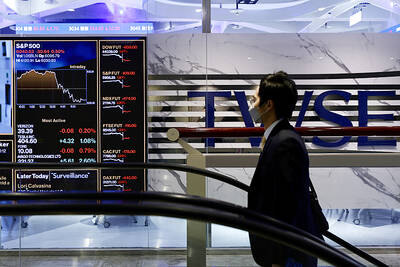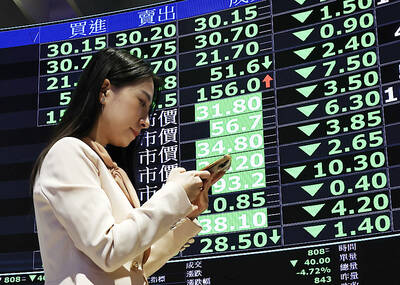Yang Ming Marine Transport Corp (陽明海運) said yesterday that global container shipping companies face challenging times before seeing a rebound in 2015 on the back of improvements in supply and demand.
Oversupply has made it difficult for major container shippers to raise freight rates, including those from Taiwan, Yang Ming chairman Frank Lu (盧峰海) said.
“It would be a big challenge for the container shipping industry to improve its performance before the end of next year,” Lu told the company’s annual general meeting.
The failure of several shipping firms to boost freight rates over the past two months also signifies a difficult year ahead, he said.
However, Yang Ming aims to break even this year through cost control and route adjustment, he said, adding that the company hopes to raise freight rates next quarter.
Shareholders of Yang Ming — Taiwan’s second-largest container shipper by fleet size — yesterday approved the company’s plan to retain all of last year’s net profit for further investment instead of distributing dividends. The company posted net profit for last year of NT$65.24 million (US$2.18 million), or NT$0.02 per share.
Besides Yang Ming, two other listed container shippers in Taiwan also held their annual shareholders’ meetings yesterday.
Evergreen Marine Corp (長榮海運), the nation’s largest container shipper, said its shareholders also agreed not to distribute dividends.
The company reported a net loss of NT$1.84 billion, or NT$0.53 per share, for the January-to-March quarter. The company reported net profit of NT$128.53 million, or NT$0.04 per share, last year.
However, shareholders of Wan Hai Lines Ltd (萬海航運), the nation’s third-largest container shipper, which focuses on intra-Asian routes, approved the company’s plan to distribute a cash dividend of NT$0.8 per share, on the back of net income of NT$1.82 billion, or NT$0.82 per share, recorded last year.
SinoPac Securities Investment Service Co (永豐投顧) yesterday maintained a relatively upbeat view for the container shipping industry in the third quarter, expressing confidence that freight rates on US and European routes would start to rebound from July.
In addition, bearish sentiment in the first half may lead some container shippers to control transport capacity more cautiously, further accelerating the rebound in freight rates, SinoPac Securities said in a research note.

SELL-OFF: Investors expect tariff-driven volatility as the local boarse reopens today, while analysts say government support and solid fundamentals would steady sentiment Local investors are bracing for a sharp market downturn today as the nation’s financial markets resume trading following a two-day closure for national holidays before the weekend, with sentiment rattled by US President Donald Trump’s sweeping tariff announcement. Trump’s unveiling of new “reciprocal tariffs” on Wednesday triggered a sell-off in global markets, with the FTSE Taiwan Index Futures — a benchmark for Taiwanese equities traded in Singapore — tumbling 9.2 percent over the past two sessions. Meanwhile, the American depositary receipts (ADRs) of Taiwan Semiconductor Manufacturing Co (TSMC, 台積電), the most heavily weighted stock on the TAIEX, plunged 13.8 percent in

A wave of stop-loss selling and panic selling hit Taiwan's stock market at its opening today, with the weighted index plunging 2,086 points — a drop of more than 9.7 percent — marking the largest intraday point and percentage loss on record. The index bottomed out at 19,212.02, while futures were locked limit-down, with more than 1,000 stocks hitting their daily drop limit. Three heavyweight stocks — Taiwan Semiconductor Manufacturing Co (TSMC, 台積電), Hon Hai Precision Industry Co (Foxconn, 鴻海精密) and MediaTek (聯發科) — hit their limit-down prices as soon as the market opened, falling to NT$848 (US$25.54), NT$138.5 and NT$1,295 respectively. TSMC's

TARIFFS: The global ‘panic atmosphere remains strong,’ and foreign investors have continued to sell their holdings since the start of the year, the Ministry of Finance said The government yesterday authorized the activation of its NT$500 billion (US$15.15 billion) National Stabilization Fund (NSF) to prop up the local stock market after two days of sharp falls in reaction to US President Donald Trump’s new import tariffs. The Ministry of Finance said in a statement after the market close that the steering committee of the fund had been given the go-ahead to intervene in the market to bolster Taiwanese shares in a time of crisis. The fund has been authorized to use its assets “to carry out market stabilization tasks as appropriate to maintain the stability of Taiwan’s

In a small town in Paraguay, a showdown is brewing between traditional producers of yerba mate, a bitter herbal tea popular across South America, and miners of a shinier treasure: gold. A rush for the precious metal is pitting mate growers and indigenous groups against the expanding operations of small-scale miners who, until recently, were their neighbors, not nemeses. “They [the miners] have destroyed everything... The canals, springs, swamps,” said Vidal Britez, president of the Yerba Mate Producers’ Association of the town of Paso Yobai, about 210km east of capital Asuncion. “You can see the pollution from the dead fish.